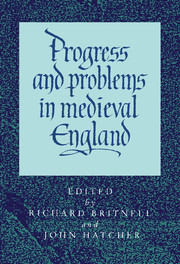Book contents
- Frontmatter
- Contents
- List of figures
- List of maps
- List of tables
- List of contributors
- Edward Miller: an appreciation
- List of abbreviations
- 1 Economic development in the early twelfth century
- 2 Lothian and beyond: the economy of the ‘English empire’ of David I
- 3 Boroughs, markets and trade in northern England, 1000–1216
- 4 Peasant deer poachers in the medieval forest
- 5 The growth of London in the medieval English economy
- 6 The bankruptcy of the Scali of Florence in England, 1326–1328
- 7 The English export trade in cloth in the fourteenth century
- 8 A medieval tax haven: Berwick upon Tweed and the English crown: 1333–1461
- 9 Taxation and communities in late medieval England
- 10 Peasants and the collapse of the manorial economy on some Ramsey Abbey estates
- 11 The famuli in the later Middle Ages
- 12 The great slump of the mid-fifteenth century
- 13 Lorenzo de' Medici's London branch
- 14 The trade of late medieval Chester, 1500–1550
- Bibliography of Edward Miller's published works
9 - Taxation and communities in late medieval England
Published online by Cambridge University Press: 05 June 2012
- Frontmatter
- Contents
- List of figures
- List of maps
- List of tables
- List of contributors
- Edward Miller: an appreciation
- List of abbreviations
- 1 Economic development in the early twelfth century
- 2 Lothian and beyond: the economy of the ‘English empire’ of David I
- 3 Boroughs, markets and trade in northern England, 1000–1216
- 4 Peasant deer poachers in the medieval forest
- 5 The growth of London in the medieval English economy
- 6 The bankruptcy of the Scali of Florence in England, 1326–1328
- 7 The English export trade in cloth in the fourteenth century
- 8 A medieval tax haven: Berwick upon Tweed and the English crown: 1333–1461
- 9 Taxation and communities in late medieval England
- 10 Peasants and the collapse of the manorial economy on some Ramsey Abbey estates
- 11 The famuli in the later Middle Ages
- 12 The great slump of the mid-fifteenth century
- 13 Lorenzo de' Medici's London branch
- 14 The trade of late medieval Chester, 1500–1550
- Bibliography of Edward Miller's published works
Summary
This essay has two purposes: first to investigate how English villages and towns organised their direct taxes after 1334, when the government gave them the task of assessing their own contributions; and secondly, of using that information to explore medieval attitudes towards hierarchy and social responsibility.
The concept of community presents historians with many dilemmas and uncertainties. On the one hand it has a solid, institutional significance which need not cause much difficulty. When the community of the vill was charged with some rent payment or public function (repairing a bridge, for example) we can be sure that we are observing practical self-government. Likewise in a town the communitas was sometimes assigned a specific constitutional role, such as the election of officials, even though there were doubts about methods of representation. The word ‘community’ also carries with it a whole range of imprecise meanings: it implies a sharing of values among its members, and a collective sense of purpose; or it might refer to the interactions between people which made them mutually dependent, and led them to co-operate. Such issues of mentality or everyday social contact are difficult to define and analyse historically. Nonetheless, it has been assumed that in the case of villages, and to a lesser extent towns, at some early period communities were strong and cohesive, and that they were threatened by economic and social change.
- Type
- Chapter
- Information
- Progress and Problems in Medieval EnglandEssays in Honour of Edward Miller, pp. 168 - 190Publisher: Cambridge University PressPrint publication year: 1996
- 8
- Cited by



